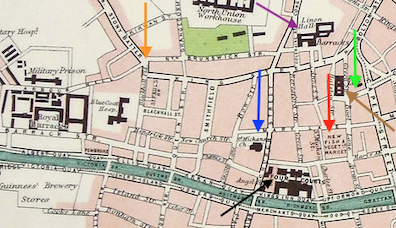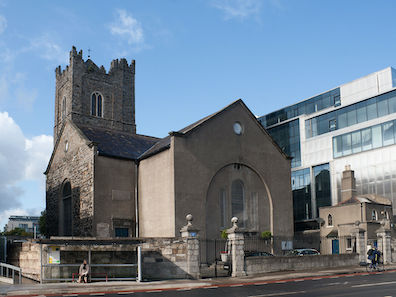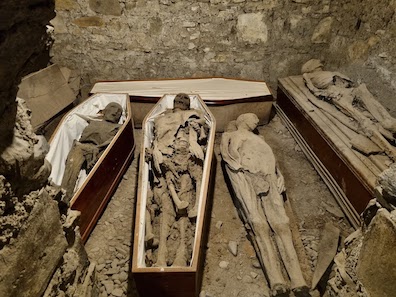The fish and produce markets evoked in the second Cyclops
parody are said to lie in "the land of holy Michan." The
name St. Michan's refers to a very old parish church that
stands northwest of the Four Courts and due west of
the markets—and also, more broadly, to the large Dublin civil
parish in which these institutions are located. When the
narrator and Joe Hynes walk to Barney Kiernan's pub from the
intersection of Arbour Hill and Stoneybatter
Road where they met at the beginning of the chapter,
they are passing by the church and the market, albeit a little
to the north.
The narrator roughly
indicates their route, just before the parodic sentences break
in: "So we went
around by the Linenhall barracks and the
back of the courthouse talking of one thing or another."
If they passed directly "by" the barracks they were walking on
North Brunswick Street, but if the word is being used more
loosely then they could have taken North King Street, one block
further south. In either case they would have then turned south
toward Little Britain Street where the pub was, passing behind a
"courthouse" that is not the Four Courts (those buildings are
some distance away on the river) but rather the city courthouse
at 26 Green Street.
The parody does not mention the barracks or the courthouse, but
it does glance at the church: "
There rises a watchtower
beheld of men afar." St. Michan's, a Church of Ireland
parish church since 1686, has a 100-foot square tower that dates
back to the 12th century. The original church was erected in
1095 by Ostmen, the Irish descendants of
Norse
Vikings. Evidently the narrator and Joe Hynes have
"beheld" the tower from "afar," over intervening buildings, as
they pass by two or three blocks to the north. Given the
parody's romanticizing of archaic Irish greatness, Gifford is
perhaps right to suppose that "the tower is associated with the
fortified round towers that were a distinguishing feature of
pre-Norman Irish religious communities." Slote and his
colleagues quote from D. A. Chart's
Story of Dublin
(1932): "The battlements at the top and the small windows at the
sides show that, like most Irish churches, it was intended to be
defensible in case of need."
Consistent with mentioning this martial "watchtower," the parody
goes on to evoke the famous contents of St. Michan's
subterranean crypts: "
There sleep the mighty dead as in life
they slept, warriors and princes of high renown." The
limestone vaults of St. Michan's have done a remarkably good job
of mummifying the many bodies laid to rest in them, including an
800-year-old man called The Crusader and several executed
leaders of the 1798 Rebellion. The ancient church, and the
ancient "warriors and princes" entombed beneath it, contribute
to the parody's evocation of Ireland's greatness before the
Saxons reduced it to a colony.


